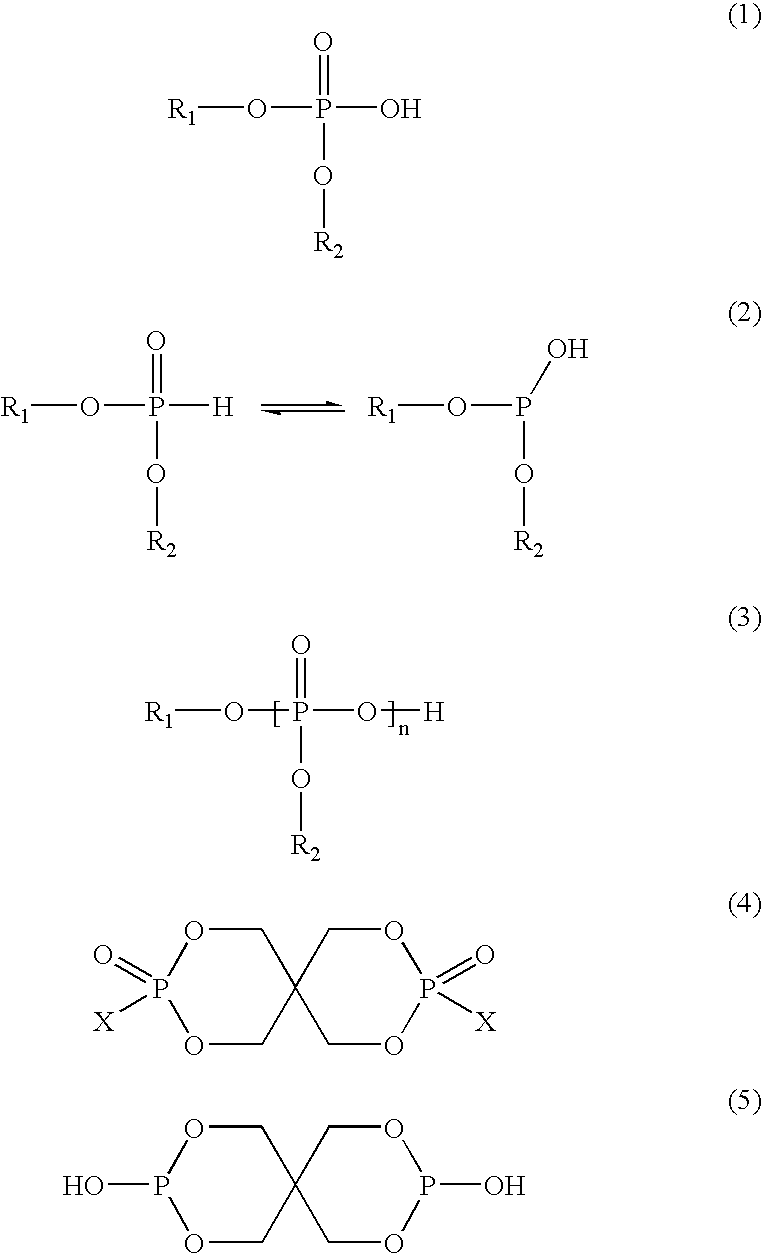Polyester compositions
a polymer composition and polymer technology, applied in the field of polymer compositions, can solve the problems of black specks or particles, reduce hydrolytic stability, corrode process equipment, etc., and achieve the effects of improving hydrolytic stability, less detrimental, and better color
- Summary
- Abstract
- Description
- Claims
- Application Information
AI Technical Summary
Benefits of technology
Problems solved by technology
Method used
Image
Examples
examples
[0107]Experimental Conditions: All polyester-polycarbonate compositions were made by extruding a 50 / 50 by weight blend of (1) a polyester comprised of 74 mole percent terephthalic acid residues, 26 mole percent isophthalic acid residues and 100 mole percent 1,4-cyclohexanedimethanol residues having an inherent viscosity of about 0.74 and containing approximately 100 ppmw titanium metal, (2) a bisphenol A polycarbonate supplied by Bayer as Makrolon 2608 polycarbonate and (3) the additive noted using an 18 mm twin-screw extruder (APV Chemical Machinery Inc., Saginaw, Mich. 48601) equipped with a medium mixing screw. All zone temperatures were set to 275° C. except for Zone 1 that was set at 250° C. The inlet port was cooled by circulating water and the screw speed was set to 200 revolution per minute (rpm). An Accu-Rate (ACCU-RATE Inc. Whitewater, Wis.) dry material feeder was used to feed the polymers and additives into the extruder at a set addition rate of 3.0. The extruded rods we...
examples 47-51
Preparation of Salts 2-6
[0127]A 50 percent phosphoric acid solution was prepared by adding 35.15 g of 85 percent phosphoric acid to 24.87 g of deionized water. A sample of Chimassorb 944 was ground to a fine powder using a mortar and pestle. The ground Chimassorb 944 and 50 percent phosphoric acid solution were mixed using a spatula in the ratios listed in Table VI to prepare each salt. The salts were dried overnight in a vacuum oven at 70° C. at about 15 Torr and a slight ingress of dry nitrogen for 24 hours. Each sample was ground using a mortar and pestle and dried under the same conditions as before for 48 hours. Each sample was ground to a fine, free flowing powder using a mortar and pestle.
[0128]
TABLE VI50 percent phosphoricChimassorb 944acid(aq)Salt 2l0 g6.54 gSalt 3l0 g8.18 gSalt 4l0 g9.82 gSalt 5l0 gll.45 gSalt 6l0 g13.05 g
[0129]Each salt (0.5 g, 0.1 wt percent) was bag blended with 250 g of polyester and 250 g of polycarbonate. The mixture was extruded under standard condi...
examples 52 and 53
Preparation of Salt 7
[0132]To a 50 mL beaker was added 5.18 g of phosphorous acid and 5.0 g of pyridine. A solid material formed. The solid material (Salt 7) was triturated with a glass rod until a finely divided solid remained. In Example 52, Salt 7 (350 mg, 0.05 weight percent) was bag blended with 350 g of polyester and 350 g of polycarbonate. The mixture was extruded using the procedures described above and the pellet color and polycarbonate molecular weight (Mw) were measured using the above-desribed procedures. In Example 53, Salt 7 (700 mg, 0.1 weight percent) was bag blended with 350 g of polyester and 350 g of polycarbonate. The mixture was extruded and pelletized and the pellet color and polycarbonate molecular weight (Mw) were measured using the above-described procedures. The results of the evaluation are shown in Table VIII.
[0133]
TABLE VIIIPolycarbonateExamplea*b*L*MnMwMz52−0.386.8268.917,80023,06738,17553−0.154.3169.947,40821,11834,892
[0134]The data reported in Table V...
PUM
| Property | Measurement | Unit |
|---|---|---|
| pressures | aaaaa | aaaaa |
| temperature | aaaaa | aaaaa |
| temperature | aaaaa | aaaaa |
Abstract
Description
Claims
Application Information
 Login to View More
Login to View More - R&D
- Intellectual Property
- Life Sciences
- Materials
- Tech Scout
- Unparalleled Data Quality
- Higher Quality Content
- 60% Fewer Hallucinations
Browse by: Latest US Patents, China's latest patents, Technical Efficacy Thesaurus, Application Domain, Technology Topic, Popular Technical Reports.
© 2025 PatSnap. All rights reserved.Legal|Privacy policy|Modern Slavery Act Transparency Statement|Sitemap|About US| Contact US: help@patsnap.com



